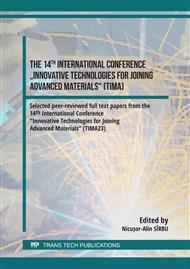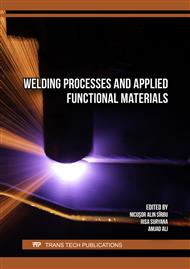p.53
p.61
p.67
p.77
p.83
p.89
p.97
p.109
p.115
Resistance of the Steel Lap Joints Connected by Spot Welding and Brazing
Abstract:
Welding technologies are constantly evolving, and their applicability is expanding, considering also the construction domain. Steel structures benefit from the advances in welding technologies due to the use of thin gauge steel sheets which can now be connected at high quality and automatically. The resistance of the connection between the thin steel sheets is crucial for the durability and safety of a structure made of built-up thin-walled cold-formed steel elements. Generally, self-drilling screws or bolts are used for the connection between thin-walled elements, but the quantity of time and manpower necessary for a large number of connections demands an improved solution. Conventional welding techniques are unsuitable for joining thin sheets, ranging from 0.4 to 1.0 mm to thicker ones measuring 1.0 to 3.5 mm. This article compares the results of an experimental investigation into lap joints connected by spot welding and MIG brazing with the design code provisions. The study examines single-lap joints in steel sheets of 0.8, 1.0, 1.2, 1.5, 2.0 and 2.5 mm thickness, connected using these welding technologies. The results obtained are then compared with analytical relations and processed according to EN 1990. Depending on the thickness of the connected sheets, spot welding can lead to two failure modes: button pull-out fracture and interfacial fracture. MIG brazing, a welding technology that deposits material below the melting point of the base material, is known for its advantages, such as low energy consumption, spatter-free operation, high welding speed, and compatibility with thin sheet metals. However, its application in the structural engineering of cold-formed elements lacks documentation. In the study, the MIG brazed specimens failed in the heat-affected zone of the connection. The results indicate the dependence of the spot weld lap joint resistance on the connected sheets' thickness, while the resistance of the MIG brazed lap joints is influenced by the minimum thickness of the connected steel sheet. The study aims to demonstrate the feasibility of the proposed solutions, evaluate their performance, and establish the limits of their applicability. A statistical interpretation of the results highlights the precision and reliability of joint resistance.
Info:
Periodical:
Pages:
97-108
Citation:
Online since:
October 2024
Price:
Сopyright:
© 2024 Trans Tech Publications Ltd. All Rights Reserved
Share:
Citation:



